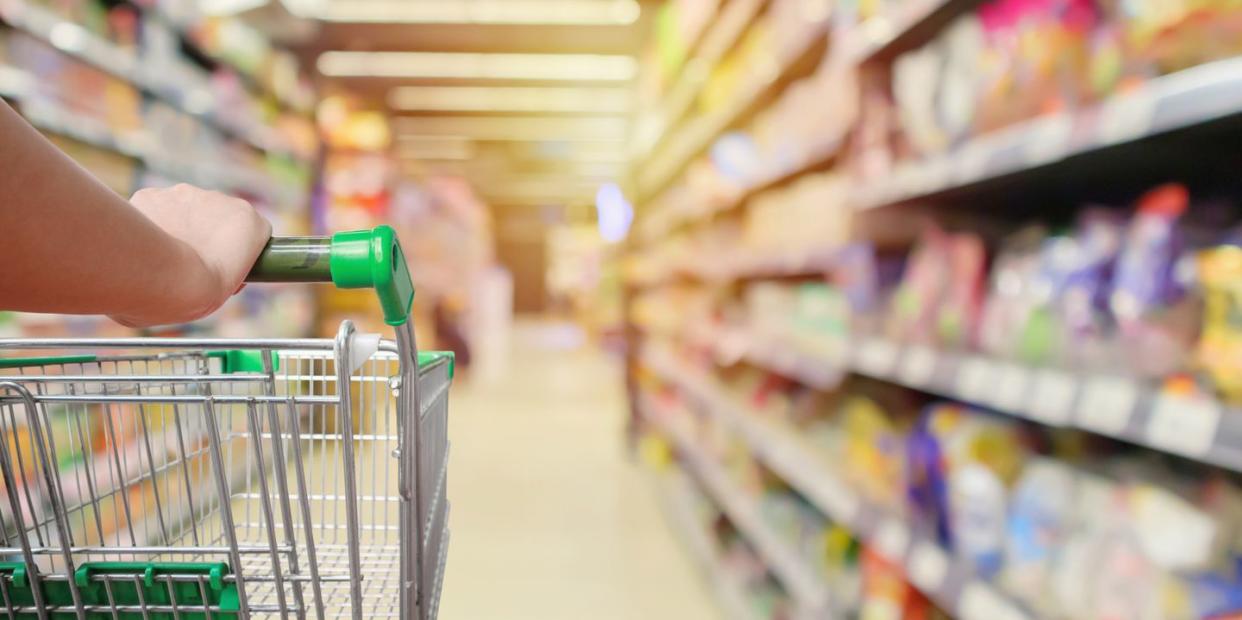8 Foods That Are the Most Expensive Right Now Due to Inflation

Inflation rates have hit historic record highs here in the U.S. and have particularly impacted grocery and food costs for consumers.
Current data organized by federal officials indicate that the cost of groceries has risen by 9% over the last year.
But certain aisles in your supermarket may contain foods that are marked up as much as 20% year-over-year, with prices forecasted to continue to spike well into 2022.
Earlier this month, the rate of inflation — the rate of increase in prices over a given period of time — here in the United States reached a 41-year historic high as consumer goods continue to be impacted by supply chain issues exacerbated by the COVID-19 pandemic, and more recently, by the war in Ukraine. The unique mix of events has caused bills to skyrocket at supermarkets as food costs increase, an issue that isn't unique to U.S. shoppers — globally, food prices crested at a record 21% increase year-over-year, according to the United Nations' Food and Agriculture Organization's (FAO) Food Price Index.
Food prices aren't uniquely impacted by rising inflation at this time as there are also impacts caused by oil prices, adding financial burden on distributors who pass the cost onto consumers, reports the New York Times. Current labor shortages also play into how the U.S. supply chain network is impacted at this time, making each food item more precious, and more in demand than ever before.
While prices at supermarkets and even local stores have been steadily increasing for the last year — upwards of 9% as a whole since early 2021, according to the U.S. Bureau of Labor Statistics' Consumer Price Index — shoppers are reeling at dramatic monthly upticks in 2022. In February alone, groceries as a whole cost around 1.5% more than they did the month prior, and forecasts for March are projected for that figure to continue rising.
Supply Chain Disruptions, Rising Commodity Prices, General CPI#AgOutlook pic.twitter.com/YMydgZK4js
— Dept. of Agriculture (@USDA) February 24, 2022
But the steady rise in prices isn't equally distributed over all the food within a grocery store evenly. It's become quickly apparent that some staples in multiple categories are experiencing spikes that are driving checkout bills to sticker-shock totals that consumers are keen to avoid.
Globally, vegetable oils' prices are up around 8.5% in February over January, driven by production costs surrounding sunflower oil, soy and palm oils, per the FAO (Ukraine and Russia currently account for 80% of global exports here). In addition, both maize and wheat prices increased dramatically in the first two months of the year, leading to a 3% increase in the FAO cereal price index in February, a figure that is likely to continue climbing in March and April.
Dairy has seen the largest increase in cost for consumers across the world, where price surging has been recorded for staples like eggs, cheese and milk over many months running. FAO's dairy price index increased just about 6% in February, a sixth-consecutive monthly uptick — compared to a mere 1% increase for the prices of meat.
That trend is true here in the U.S., as local reports indicate that milk and other dairy items are being marked up most dramatically this year. While all six major grocery categories, which include everything from packaged baked goods to nonalcoholic beverages, saw month-over-month prices increase in February, dairy saw its largest month-over-month uptick in more than a decade, per the Bureau of Labor Statistics (BLS).
The FAO Food Price Index and individual commodity price indices, to Feb 2022#AFPgraphics @AFP pic.twitter.com/rJ68u6zTCm
— AFP News Agency (@AFP) March 15, 2022
Only one other category saw a more dramatic price increase: Fresh fruit and vegetables. "The index for fruits and vegetables had the largest increase, rising 2.3%, its largest monthly increase since March 2010," the BSL's most recent index report reads.
Using data provided by the BSL, analysts have indicated there are clear-cut items that are becoming the most expensive in the supermarket in their respective categories. These items are seeing consecutive above-average inflation price hikes over the last year:
Beef: 16.2%
Bacon: 18.8%
Chicken: 13.2%
Coffee: 10.5%
Flour and flour mixes: 11.6%
Fresh fruit: 10.6%
Milk: 11.2%
Oils and fats, including peanut butter: Between 11% and 15.6%
Analysts have recalculated their 2022 forecasts for grocery prices after current rates, largely impacted by international conflict, have significantly surpassed expectations in the first two months of the year. Officials in the U.S. Department of Agriculture have released updated guidelines acknowledging that a recent increase in interest rates by the Federal Reserve is expected to put further pressure on food prices in the future.
"All food prices are now predicted to increase between 4.5 and 5.5%," the report reads. "Food-at-home prices are predicted to increase between 3 and 4% in 2022."
While grocery budgeting is going to be more important than ever in 2022, all hope isn't lost for shoppers — there are ways to continue to save at the register. CNBC financial experts compiled a list of ways that all Americans can save money starting now, including signing up for cash-back apps and leveraging cash-back rewards on credit cards. Plus, grocery delivery services are extending more discounts, looking to increase the number of rewards and coupons given to customers. A brand representative for Instacart tells Good Housekeeping that in-app deals and coupons saved customers upwards of $500 million last year; a sign that coupon clipping can still help offset a portion of rising costs.
You Might Also Like

